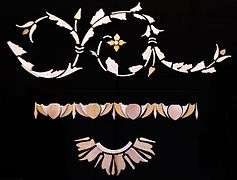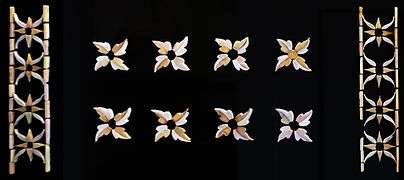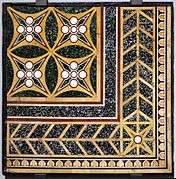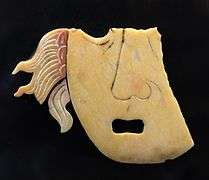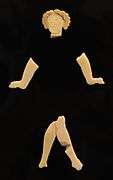Domus Transitoria
The Domus Transitoria was Roman Emperor Nero's first palace destroyed by the Great Fire of Rome in 64 AD, and then replaced by his Domus Aurea (or Golden House).

History
The palace was intended to connect all of the imperial estates, which had been acquired in various ways, with the Palatine including the Horti of Maecenas and Horti Lamiani, Lolliani, etc.[1]
According to Suetonius (Nero 31.1): "He built a palace extending all the way from the Palatine to the Esquiline, which at first he called the Domus Transitoria, but when it was burned down shortly after its completion and rebuilt, the Golden House".
Layout and Discovery
A few isolated parts of the palace have been discovered but the overall plan remains unclear.
Temple of Venus and Rome
5 metres below Hadrian's Temple of Venus and Rome a sumptuous rotunda belonging to the palace was discovered in 1828, cut through by foundations of the Domus Aurea.[2]
Oppian Hill
Another part is thought to be on the western side of the Oppian Hill under the Baths of Trajan.[3]
The brick walls of the palace were originally covered with marble at the bottom, while the upper parts were frescoed. A portico was in front of the domus along the south side. Almost all of the columns, floors and marble walls were removed when Trajan gave orders to build his baths (in 104 AD).[4]
Inside is a big courtyard with porticos on three sides, while the fourth on the north consisted of a cryptoporticus which supported the rear embankment. At the centre of the courtyard, occupied now by a series of long wall to support the overlying trajanic baths are the remains of a fountain; on the eastern part is a large grotto that opens to the courtyard.
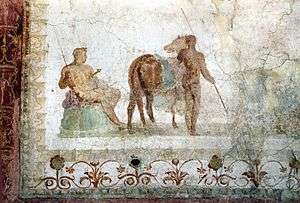
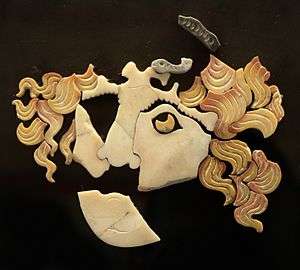
Nymphaeum of Polyphemus
An elaborate nympheum was unfortunately divided in two by a wall of Trajan. Surrounded by a portico of four columns it was equipped with a cascading fountain on the bottom, whose water was conveyed into a central basin. On the walls of the grotto was a mosaic of which only few traces remain within a frame of shells. The lower part of the walls were originally covered in marble.
The decoration of the vault, 10 m high, is preserved only in part where four corner medallions and a central octagon were inserted, the latter partly preserved representing the Polyphemus scene.
Palatine Hill
A large and brilliantly decorated set of rooms of the palace was also located in the central part of the Palatine Hill under the Palace of Domitian. This site was excavated in 1721 when considerable damage was done during the excavations. The lower floors contained sunken gardens, two pavilions, a nymphæum, and an art gallery. Beyond these rooms is a very large latrine, which has been wrongly thought to be the machinery chamber of a hydraulic lift, which would, it was supposed, have worked in a shaft over 35 metres (120 feet) deep found not far off.[5]
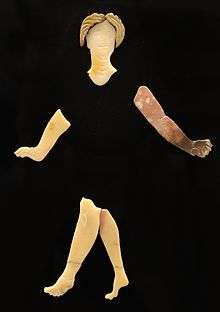
In one of these rooms is a rich marble floor found under the oval fountain room of Domitian's Cenatio Iovis, and a rich nymphaeum with marble columns and bronze capitals. Today one corner of the nymphaeum has been rebuilt.
The cryptoporticus of Nero that connected the house with the nearby Domus Tiberiana was also part of the complex.
Marble and other parts salvaged from the ruins later became part of the Domus Aurea, Nero's main residence.
Painted ceilings with mythological scenes from the Domus Transitoria, the earliest examples of fourth style painting, perhaps by the painter Fabullus are displayed in the Palatine Antiquarium.
References
- ↑ http://penelope.uchicago.edu/Thayer/E/Gazetteer/Places/Europe/Italy/Lazio/Roma/Rome/_Texts/PLATOP*/Domus_Transitoria.html
- ↑ The Architecture of the Roman Empire: An Introductory Study, Volume 1, William Lloyd MacDonald, p 23
- ↑ Filippo Coarelli, Rome, Bari and Rome, Laterza, 2012 p 237
- ↑ Filippo Coarelli, Rome, Bari and Rome, Laterza, 2012 p 232
- ↑ Samuel Ball Platner (1929). "A Topographical Dictionary of Ancient Rome". Oxford University Press. Retrieved 2009-07-18.
